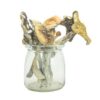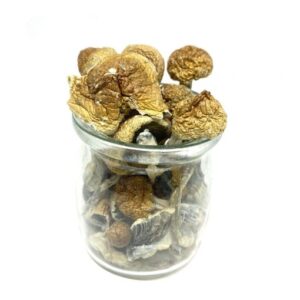Cambodian Mushroom
$300.00 – $4,500.00
Buy Bulk Shrooms Online – Cambodians Mushrooms
This is a very nice mushroom from South East Asia. The spores were discovered at the famous Angkor Wat temple. The Cambodian strain is considered to be a potent cubensis, delivering a very nice energetic high that tended to last quite a while. Its not an extremely intense experience, just very energetic and last a long long time. Very smooth as well without much body noise. This one really wakes you up in a beautiful way. If you like the energetic journeys from these mushrooms, this is your ticket to an all-night exploration.
Table of Contents
ToggleCambodian Mushroom
Cambodian Mushroom are a strain of magic mushrooms initially isolated from a wild one in Cambodia sometime in the early 90s.
This strain is considered one of the most robust and disease-resistant, even if the growing conditions are underoptimized. Some strains are more susceptible to contamination than others, which can be the bane for new and experienced mushroom growers. Sometimes no matter how much care and attention you place while inoculating your spawn jars, you’ll still encounter contamination problems before you get a chance to collect on the fruits of your labor.
The resilience of this strain makes them a great candidate for beginners but is also an excellent option for more experienced growers.
The Cambodian strain falls a bit short on potency, however. The average tryptamine levels of this strain are below 0.6%.
The original sample for this strain was found near the ancient temple of Angkor Wat, one of the largest religious temples ever discovered. It’s believed that the ancestor strains of the Cambodian strain may have been eaten by religious leaders who were active in the temple after it was constructed in the 1100s.
Cambodian Shroom Specs
| Potency | Weak 🐁 |
| Cultivation | Beginner |
| Species | Psilocybe cubensis |
| Substrate Recommendation | Rye Grain or Brown Rice Flour |
| Cost | $ |
| Sold By | Ralphsters Spores, Spores 101, Premium Spores, Free Spores |
Cambodian Shrooms Potency & Psilocybin Content
Potency testing on the Cambodian strain is a bit of a sore spot with growers. This strain is really easy to grow and produces plenty of mushrooms over several harvests — but the general potency is considered weak by all standards.
Testing provided by Oakland Hyphae found the average psilocybin and psilocin of this strain to be a mere 0.45% and 0.06%, respectively. The total tryptamine content was just 0.57%.
There’s some conflicting information here, however. Some Reddit posts suggest this strain to be above average in terms of potency. Even John Allen’s initial report on these mushrooms suggested they were heavy hitters.
The truth is that the potency of Cambodian mushrooms (like many strains) is very highly dependent on growing conditions. If grown in optimal conditions, it’s likely on par with some of the other potent shrooms out there — but most of the time, they’re going to be a bit lackluster.
That said, these mushrooms will still produce powerful hallucinogenic effects at doses of around 2 grams or higher
Where to Buy Cambodian Shroom Spores
If you’re looking to grow Cambodian shrooms, there are a few places you can turn to to get your spores.

If you live in the United States, two of the best spore vendors that carry this strain are Ralpster’s Spores and Spores 101.
If you live in Canada, you can check out Sporeslab or Myco, which are great resources and carry the Cambodian strain most of the time.
If you live in Europe, Kosmic Kitchen, Viking Spore, and the Magic Mushrooms Shop are good places to try instead.
Related: How & Where to Buy Magic Mushroom Spores (Legally).
How to Grow Cambodian Shrooms
There are many good reasons to grow the Cambodian cubes strain — prolific fruiters, disease resistance, and gentle effect profile — just to name a few.
We’d even go so far as to say the Cambodian strain is one of the best for new growers.

As with any strain, it’s important to prioritize keeping a sterile environment during the inoculation phase and ensure the mycelium doesn’t overheat during incubation.
For more detailed information on how to get started growing magic mushrooms, check out our extensive beginner’s guide
We’ve found that the first flush with this strain is almost always the most prolific. Second and third flushes can provide impressive yields too, but they usually have a sharp drop-off by the fourth flush. If you get stuck between flushes, you can use an ice water bath to stimulate new growth.
Similar Strains
Cambodian shrooms are highly sought-after in the magic mushroom community and are one of our top recommendations for new growers — but they aren’t our only recommendation.
Whether you’re having difficulty finding Cambodian shroom spores or you’re just looking for similar strains to go for instead, here are some other options worth your consideration:

Allen Shrooms
The Allen shroom strain is named after John W. Allen, the same mycologist who discovered the Cambodian strain. In fact, the Allen strain was discovered during the same excursion through Asia, although it was isolated from a wild shroom sample in Thailand. The Allen strain has rapid colonization times, just like the Cambodian strain, and it’s relatively easy to cultivate even for novices.

Ban Hua Thanon Shrooms
The Ban Hua Thanon shroom strain also called the BHT strain, is yet another that was isolated during “Mushroom John” John Allen’s trip to Southeast Asia. This strain has good resistance to high temperatures, it’s a fairly quick colonizer, and it’s easy for any cultivator to grow, regardless of experience.

Burma Shrooms
The Burma mushroom strain hails from Myanmar, which isn’t far from where the Cambodian strain was initially isolated. This strain — sometimes called the Burmese strain — was taken by a student in Thailand, who later gifted it to John Allen for his research. Like Cambodian shrooms, the Burma strain is known for its high potency and ease of cultivation.
Ban Phang Ka Shrooms
Finally, Ban Phang Ka shrooms — or just BPK shrooms — come from Thailand and were, unsurprisingly, originally isolated by Mushroom John Allen. This strain is quite rare, so it’s challenging to find spore samples available. It’s a bit more challenging to cultivate than Cambodian shrooms as well, and the potency is slightly lower, usually coming in around average.
Koh Samui
Our editor, Justin Cooke, recommends Koh Samui as his favorite to grow. It’s a fast colonizer and is extremely easy to work with. This shroom will thrive on basically any growing media you throw at it — it’s not picky whatsoever, which makes it perfect for low-budget mushroom setups.
The trip from these shrooms is also notoriously smooth. They’re strong, but not so strong that you will be left reeling after the trip.
Strains vs. Species: What’s The Difference?
A strain is a genetic variant of a biological species. On the other hand, a species refers to a distinct group of reproducible organisms. Two strains from the same species can reproduce, but two samples from different species cannot.

We use strains to separate members of a species that display unique growth traits. This is used for virtually all species of human importance — including cannabis, apples, grapes, tea, and much more.
There are many species of psychedelic fungi, but most of what we refer to as “mushroom strains” are sub-varieties of the Psilocybe cubensis species.
| Weight | 4 Ounces, 8 Ounces, 1 Pound, 5 Pounds, 10 Pounds |
|---|
Be the first to review “Cambodian Mushroom” Cancel reply
Related products
MUSHROOMS
MUSHROOMS
MUSHROOMS












Reviews
There are no reviews yet.